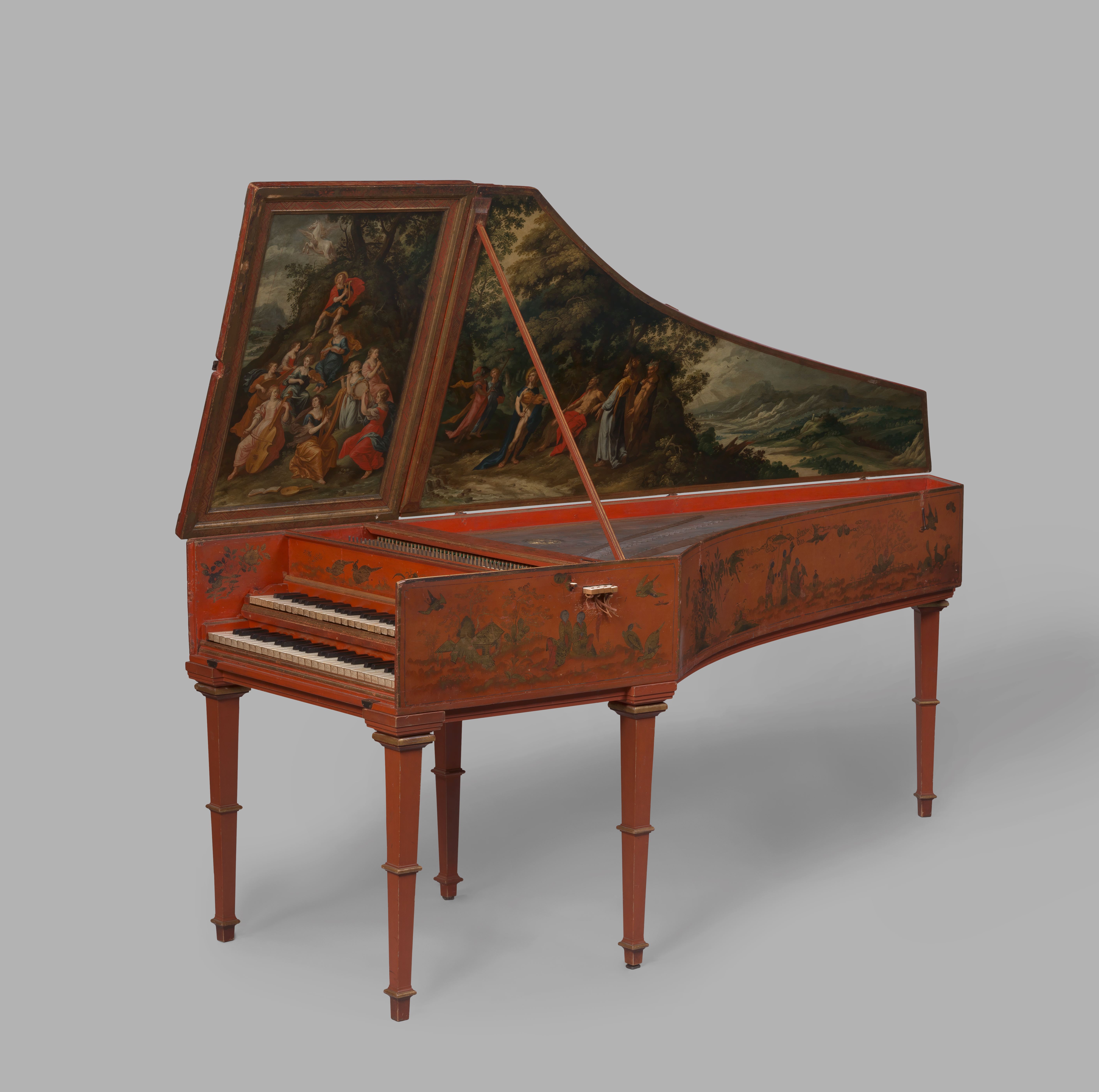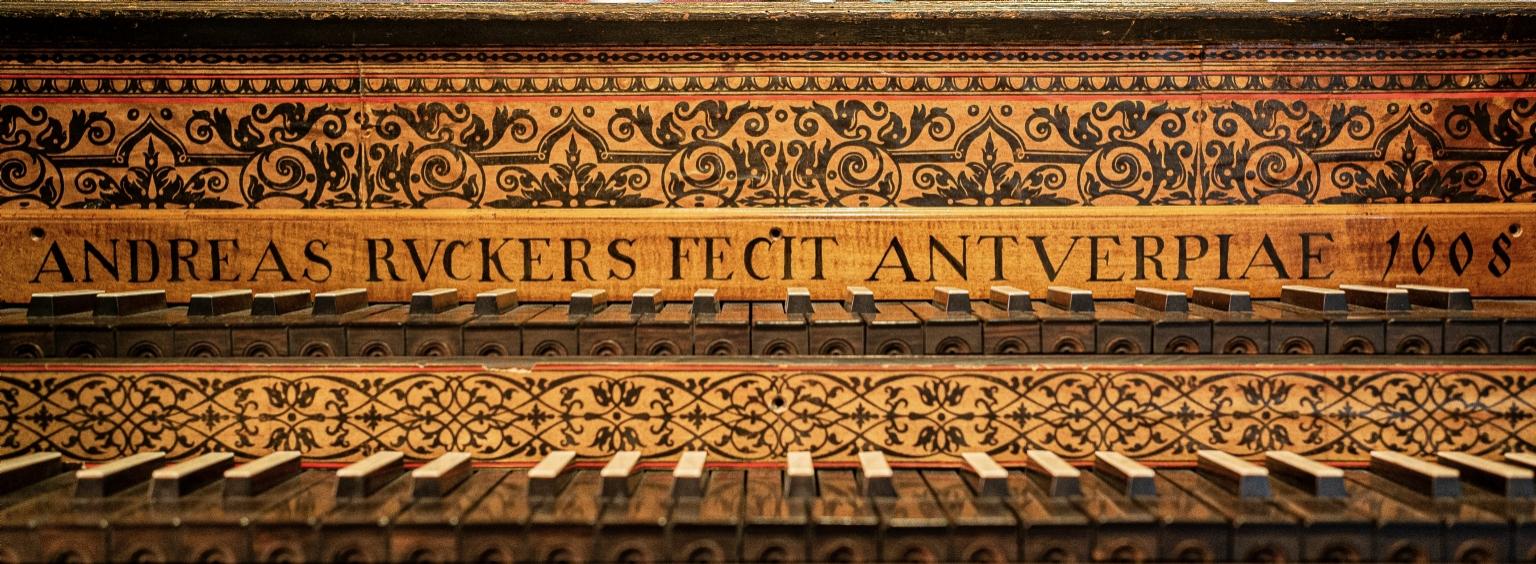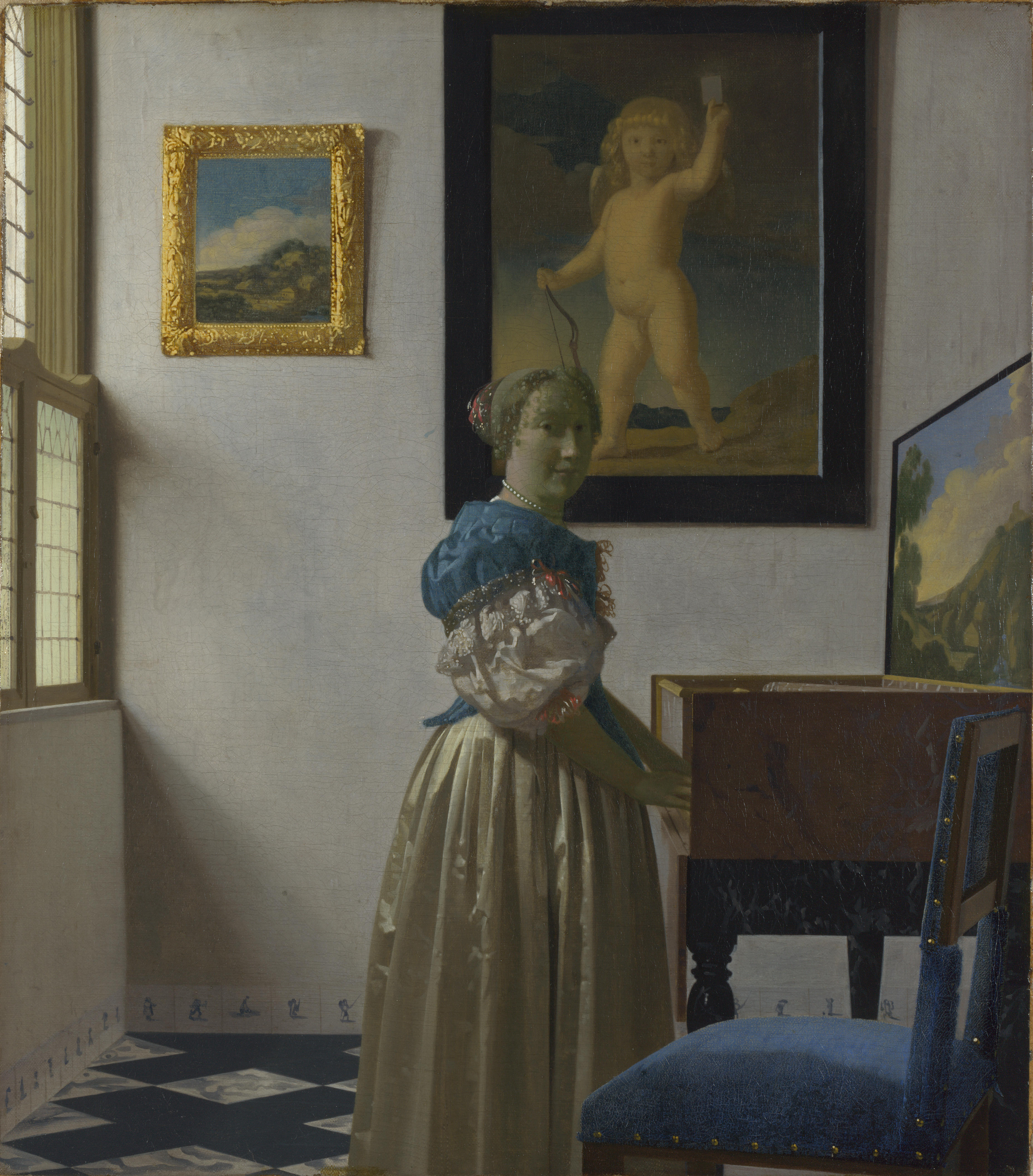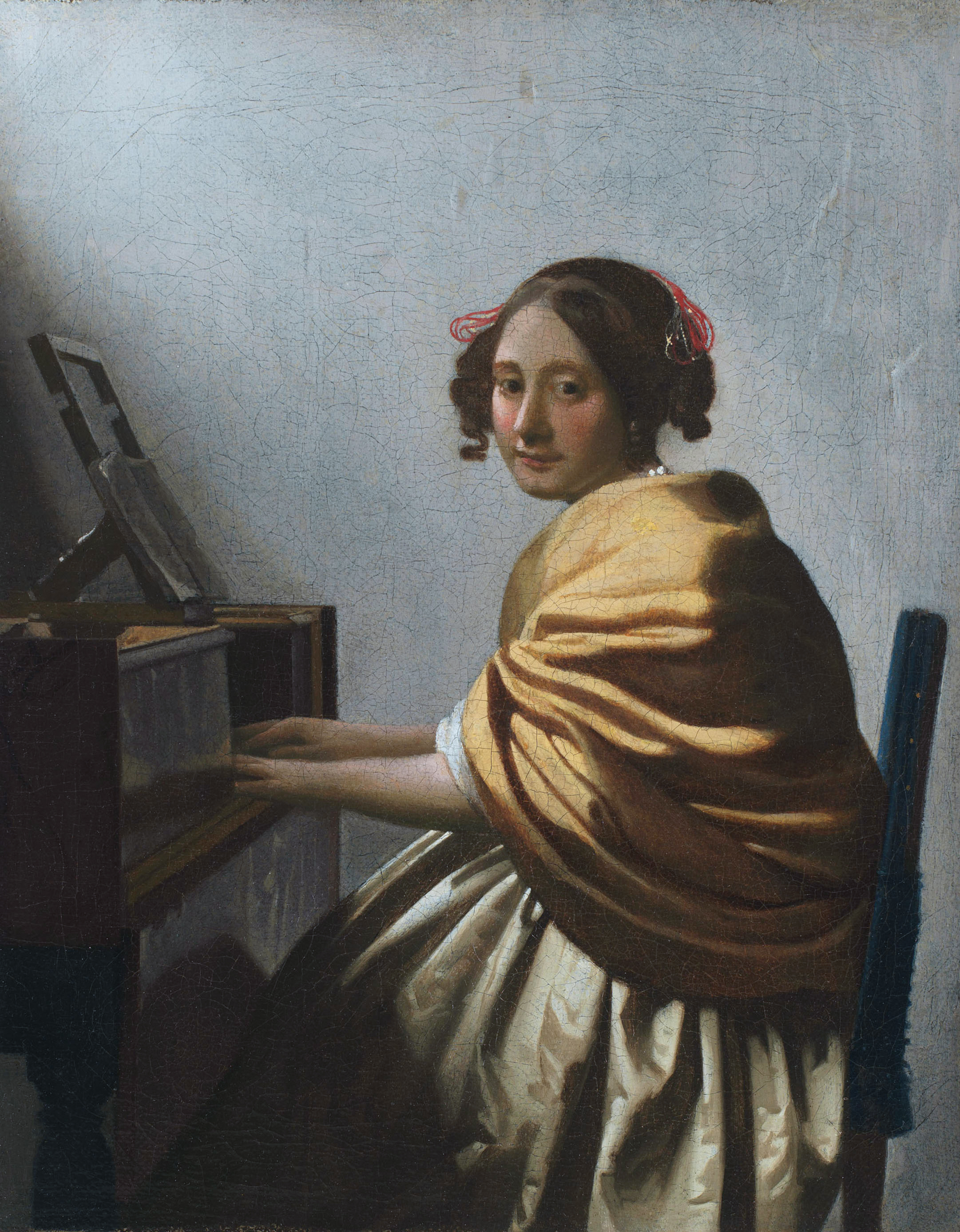- Joannes Ruckers (15 januari 1578 – 29 september 1642), de oudste zoon, volgde zijn vader op in het familie-atelier en werd in 1611 lid van de Sint-Lucasgilde.

Harpsichord, Johannes Ruckers, 1640
RUCKERS CLAVECIMBEL RIJKSMUSEUM
Klavecimbel met dubbel klavier. De binnenkant van het deksel is versierd met twee originele schilderijen die de strijd tussen Apollo en Pan weergeven op basis van Het oordeel van Midas van Hendrick Goltzius (1590). De voorklep geeft Apollo en de Muzen op de berg Helicon. De buitenkant werd in de 18e eeuw opnieuw beschilderd met rode chinoiserie-decoratie.

Andreas Ruckers & Pieter Codde
When Andreas Ruckers made this double-keyboard harpsichord in 1608 it was fit for a queen. A century after it had been owned by Queen Christina of Sweden the instrument was converted to a piano, a major operation that involved removing a keyboard and replacing the entire internal mechanism. The piano was restored to its original harpsichord form in 1928.This harpsichord was originally a transposing instrument like the other doublemanual Ruckers in the collection. The two keyboards in the instrument were aligned and brought to the same pitch in the late 17th-century when the number of strings to each note was also increased from two to three. In the 18th century it was then converted to a pianoforte and the upper keyboard removed. (Work of Johannes Lodewijk Dulcken?)

1775 Gazette van Gend, Jan Meijer, 06/07/1775
"Le Sieur Louis DULCKEN, d’Anvers, informe le Public qu’il a fait venir ici, à Gand, deux instruments à claviers sortant de ses ateliers, à savoir un clavecin et une nouvelle invention de son crû, un piano forte, grâce auquel, de façon aisée et discrète, on peut diminuer le son ou l’arrêter à volonté. Ces instruments sont exposés et mis en vente à l’auberge Den Duydsch, près de l’église St Jacob. Les amateurs pourront tester et jouer les instruments eux-mêmes." (traduction) Gazette van Gend, Jan Meyer, 06/07/1775, p. 49

1776 WEKELIJKS NIEUWS UYT LOVEN, 26/05/1776
"JEAN LOUIS DULCKEN, Meester Orgel en Clavecimbel-maeker van Antwerpen, is al hierbinnen Loven [Leuven] gearriveert met een Stuck van syn Werk, zynde een CLAVECIMBEL van vyf Octaven met een nieuw inventie aen het selve, om sonder de handen, van het Clavier den toon te doen crescéren en diminuéren. NB. dese soo nuttige inventie voor 't Musiek, kan aen alle andere stucken (sonder dat de selve moeten los gedaen oft verandert worden) aengebragt worden. Den maeker repondeert thien vervolgende jaeren Voor syn Werk, en is gelogeert in de Gulde-handt op de Visch-markt, alwaer het selve stuk te sien is." Wekelyks nieuws uyt Loven, 26/05/1776, p. 338

DAt’er in den Haeze-Wind op de Koorn-Markt binnen deze Stad te zien en te koopen is een Steirt-Clavecimbel met dobbele Clavieren en vyf Registers, gemaekt door Daniël Dulcke tot Antwerpen in 1740, en nu onlangs door zynen zoon tot vyf Octaven compleet gebragt met een nieuwe ondervindinge, waer door men den Toon kan doen verminderen en ophouden, voor welk mechanicq Werk den voornoemden Zoon de thien eerstkomende jaeren verantwoord.
Gazette van Gend 1777
The restoration to a harpsichord followed in the 1920s. The lid painting of this instrument is particularly fine, and signed “PCIV” on the upper edge of the closed book depicted in the painting. This may be the initials of Pieter Codde (1619-1666). (Raymond Russell Collection).
PIETER CODDE
PAINTER - POET - LUTE PLAYER - ART DEALER
In 1631, Pieter Codde and his wife Maritge Arents Schildt settled near the old St. Anthoniepoort at the end of the Anthoniebreestraat, in a house they rented from the nearby “Leprooshuis”.
The area soon evolved into an artist’ colony, owing to its close proximity to the Painters Guild House and found among Codde’s neighbors were Rembrandt, Pieter Potter and others. He produced several history works and a considerable number of portraits. In 1637, he finished the so-called Meagre Company, now in the Rijksmuseum, an Amsterdam militia piece begun by Frans Hals (1582/83-1666) in 1633. He was particularly prolific during the 1620s and the 1630s, rarely signed after 1645, but remained active as a painter in the 1650s.
Codde was active in both artistic and literary circles. In 1627, the poet and playwright Elias Herckmans (c. 1596-1644) dedicated his tragedy Tyrus to the artist, inspired by Codde’s now lost painting of the subject. In 1633 Codde’s own poem of pastoral love ‘Waerom vlucht ghy Millibe’ was published in the volume of poetry Hollands Nachtegaeltjen.
VIDEO: Waerom vlucht ghy Millibe 






- Hij stond onder meer in voor de onderhoud van verschillende kerkorgels in Antwerpen. Hij signeerde met IR midden een medaillon.
- Hij werkte onder meer voor de aartshertogen Albrecht en Isabella. Zijn neef Joannes Couchet kwam bij hem werken in 1627.
Joannes Couchet, (2 februari 1615 - 30 maart 1655), was de zoon van Catharina Ruckers. Hij werkte in het atelier van zijn oom Johannes tot aan diens dood in 1642 en nam toen de opvolging. Het jaar daarop werd hij lid van de Sint-Lucasgilde. Hij werd nog befaamder dan de Ruckers. Verschillende van zijn kinderen traden in zijn voetsporen, alhoewel ze niet meer dezelfde reputatie konden hoog houden.


Universiteit Leiden
JOANNES COUCHET [ANTWERPEN] AAN [CONSTANTIJN HUYGENS (DEN HAAG)] [ROND 1 AUGUSTUS 1648]
Discreten Menheer, my ombekent,
Soo laete UE. weten alsdat ick UE. dees claversingel gemaeckt hebbe nae UE. orden, te weten een unison, den reghten toon ende het clauwier tot ef-fa-ut de octaef leeger; is met Menheer Duartens sin oock soo doen maeken. ’t Is d’eerste die ick soo gemaeckt hebbe. UE. magh wel peysen, al betaelden UE. 100 pattekons, dat UE. niet een stuyver te veel sout betaelen van kunst wegen ende resonantie die het heeft. Soo sal UE. believen te sorgen die se sal stellen, welck ick verstaen Seigneur Pater, UE. vrindt, is, die just nu tot Brussel is ende heeft se noch niet gehoort. Verwaght hem alle daegen wederom tot mijnen huyse, dat, als hij se sal stellen, altijt op den reghten toon stelt, waervan UE. een fluytien, sijnde om gi-sol-re-ut daerop te stellen, soo sal UE. altijt de resonantie volcomen hooren, want staet se te leegh oft te hoogh, soo corompeert de resonantie ende niet coreckt dan en spreckt als se gemaeckt woort. Dit doende sal mij eer geschieden van mijn werck. Niet eens en twijfel oft se sal UE. te vollen contenteren, waervan een letter sullen antwort verwachten ende UE. belieft oft alles oock naer UE. sin is gemaeckt.
Voorts, soo d’ocasie noch eens quam om voor een ander liefhebber noch een te moeten maecken, sou het raeden om de selve sorte met een octaefken te laeten maeken, dat sou mijnen sin sijn. Die gaen snelder ende scherper dan den unison, is suet ende liefelijck van clanck. Dan sou UE. eens de defferentie hooren. Heb een met een octaefken gemaeckt als dese is van clauwier, maer is een toon hooger ende met een octaefken. Unison is in Antwerpen noch niet. Menheer Duart is noot weke bijnaer, oft gaet dien liefhebber besoeken om sijn claversingel te hooren ende cost hij se uyt sijn handen crijgen, hij sou niet lanck mede toeven. Moet voor hem nu soo een gaen maeken.
Hiermede van herte seer begroeyt ende Godt bevolen.
UE. dienaer Jean Couchet, claversingelmaeker.
Joannes Couchet
Antwerpen: baptized on 1615-02-02
Antwerpen: buried on 1655-04-04
Father: Carolus Couchet (? - 1655)
Mother: Catharina Ruckers (1593 - 1625)
Marriage:
Angela van den Brant (? - 1667), Antwerpen 1643-12-26
Children:
Joannes Couchet (1644 - ?)
Joannes Josephus Couchet (1652 - 1706)
Abraham Cornelius Couchet (1655 - ?)

Portrait of Constantijn Huygens (1596-1687) - Caspar Netscher
Signature and date bottom left: C. Netscher Fec. 1672
Grafdicht (Huyghens)
In dese kromme kist rust Ian Couchet; met reden:
Sij beeldt syn ambacht uijt en past nett op syn’ leden;
De korst na de Pasteij. Dan, leser, weet daer bij,
Hy ligt niet op syn’ rugg, maer op syn’ slincke zij.
Andreas (I) Ruckers (30 augustus 1579 – na 1645) werkte eerst samen met zijn broer maar stichtte in 1608 zijn eigen atelier. Hij trouwde in 1605 en had minstens drie kinderen. De instrumenten die hij bouwde en die bewaard zijn gebleven, zijn gedateerd uit 1607 tot 1644 en zijn zowat over de hele wereld verspreid.
Andreas (II) Ruckers (31 maart 1607 - voor 1667), zoon van Andreas I, werd in 1637 lid van de Sint-Lucasgilde. Hij werkte samen met zijn vader, die hij amper drie jaar overleefde. Getrouwd met Joanna Hechts, met wie hij zes kinderen had. Zij stierf aan de pest in 1653. Er zijn zeven door hem gebouwde instrumenten bewaard en bevinden zich in verzameling verspreid over de wereld. Hij was de laatste Ruckers.
Anna Catherina Ruckers (1615 - na 1672), dochter van Andreas I Ruckers, trouwde opeenvolgend met Carolus Couchet en met de schilder van stillevens Jan Davidsz. de Heem met wie ze in 1644 in het huwelijk trad.
Joannes Couchet
Antwerpen: baptized on 1615-02-02
Antwerpen: buried on 1655-04-04
Father: Carolus Couchet (? - 1655)
Mother: Catharina Ruckers (1593 - 1625)
Marriage:
Angela van den Brant (? - 1667), Antwerpen 1643-12-26
Children:
Joannes Couchet (1644 - ?)
Joannes Josephus Couchet (1652 - 1706)
Abraham Cornelius Couchet (1655 - ?)



Charles Burney (1726-1814) took on the three roles of music historian, composer, and musician. His first music books, The Present State of Music in France and Italy… (London, 1771) and The Present State of Music in Germany, the Netherlands, and the United Provinces… (London, 1773), were the results of his extensive travels around Europe. His 1770 trip took him from London to Paris, Geneva, Turin, Milan, Padua, Venice, Bologna, Florence, Rome, and Naples. His second tour, through Germany and the Low Countries, resulted in his second book. All of this was in support of his General History of Music, which came out in 4 volumes (I: 1776, II: 1782, III and IV: 1789).
His daughter, the novelist Frances (Fanny) Burney, wrote a biography of her father after his death in 1814. The Memoirs of Doctor Burney, three in volumes, appeared in 1832 and is where much of the information about Burney’s social circles comes to life.
Dr. Burney's Musical Tours in Europe, Volume II. An Eighteenth-Century Musical Tour in Central Europe and the Netherlands
Harpsichord-makers
The famous harpsichord-makers, of the name of Ruckers, whose instruments have been so much, and so long admired all over Europe, lived in this city: there were three, the first, and the father of the other two, was John Ruckers (1) who flourished at the beginning of the last century. His instruments were the most esteemed, and are remarkable for the sweetness and fulness of their tone. On the left hand of the sound-hole, in the bellies of these instruments, may be seen a large H, the initial of Hans, which, in the Flemish language, means John. André the eldest of John's sons, distinguished his work, by an A, in the sound-hole. His large harpsichords are less esteemed than those made by any one of that name; but his small instruments, such as spinets, and virginals, are excellent. Jean, the youngest son's harpsichords, though not so good as those of the father, are very much esteemed for the delicacy of their tone; his instruments may be known by the letter I, in the sound-hole. The harpsichord-maker of the greatest eminence, after them, was J. Dan. Dulcken; he was a Hessian. At present there is a good workman at Antwerp, of the name of Bull,(2) who was Dulcken's apprentice, and who sells his double harpsichords for a hundred ducats each, with only plain painted cases, and without swell or pedals; the work too of Vanden Elsche, a Flamand, has a considerable share of merit; but, in general, the present harpsichords, made here after the Rucker model, are thin, feeble in tone, and much inferior to those of our best makers in England.
I cannot quit this city, without mentioning a particular mark of attention, with which I was honoured by father Gesquiere, the night before my departure. In the morning he had communicated to me a very ancient Latin manuscript upon music; but though the writing proved it to be of great antiquity, we could not exactly fix the date of it; there were likewise some letters of the alphabet, used as musical characters in it, which were not easy to determine, as it was difficult to distinguish an A from an O, or a D, on account of the great resemblance of these letters in the manuscript; but by a note written in elegant Latin, with which he favoured me at night, I found that these difficulties had occupied his mind the whole day; indeed he seemed entirely to have spent it in trying to clear up the first, and offered his future service in removing the last.
(1) Ruckers. The famous family firm was active in Antwerp from about 1580 to about 1670. Grove
has a very full account of the family and a descriptive catalogue of the instruments made by them, so far as these still exist.
(2)Bull The great English harpsichordist and harpsichord composer, Dr. John Bull (c. 1562-1628) spent his last eleven years as organist of Antwerp Cathedral, and it is to be regretted that Burney did not seek out the Antwerp Bull of his day and inquire as to his descent and as to possible local raditions concerning him.





 Foundation Musick's Monument
Foundation Musick's Monument